Live Aid in Philly: An Oral History of that Crazy Day at JFK
In their own words, superstars Tina Turner, Robert Plant and Jimmy Page and locals like Patti LaBelle, Pierre Robert, Stephen Starr and Robert Drake explain what it was like.
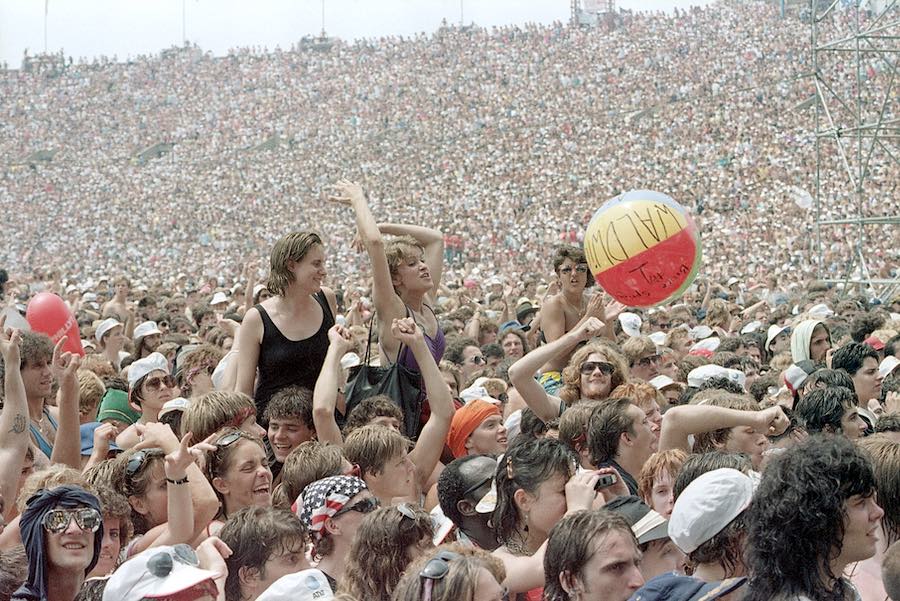
The crowd at the Philadelphia edition of Live Aid at JFK Stadium on July 13, 1985 (Getty Images)
It was July 13, 1985. Two months earlier, Philadelphia had made international news when it dropped a bomb on its own citizens.
But on this day, as many as two billion people across more than 100 nations were watching our city for a much different reason: Live Aid, a concert that we landed only by virtue of having what was then one of the country’s largest venues, JFK Stadium.
While Queen, U2 and Paul McCartney dominated the London portion of the two-venue, two-continent simultaneous event, Philadelphia played host to skyrocketing pop star Madonna, icons Mick Jagger and Bob Dylan, an unfortunate Led Zeppelin reunion, and hometown heroes like the Hooters, Hall & Oates, Teddy Pendergrass and Patti LaBelle — all coming together to raise money for famine relief in Africa and sing “We Are the World” while some 100,000 people in 95-degree summer heat looked on.
Conceived by Irish rocker Bob Geldof and pulled off with the help of legendary San Francisco concert promoter Bill Graham and Electric Factory co-founder Larry Magid, it was an event unlike any the world had ever seen — or will ever see again.
In 2015, Philly Mag published a version of this oral history, titled “Sex, Drugs and Live Aid.” Since then we’ve interviewed other stars and fans and also delved into historical archives for accounts from other sources who were at Live Aid.
Here, the people who were there that day explain what it was like to be part of Live Aid, from performers like Tina Turner, Led Zeppelin’s Robert Plant and Jimmy Page, and Patti LaBelle to locals Pierre Robert, Robert Drake and Jerry Blavat and a then-young concert promoter by the name of Stephen Starr.
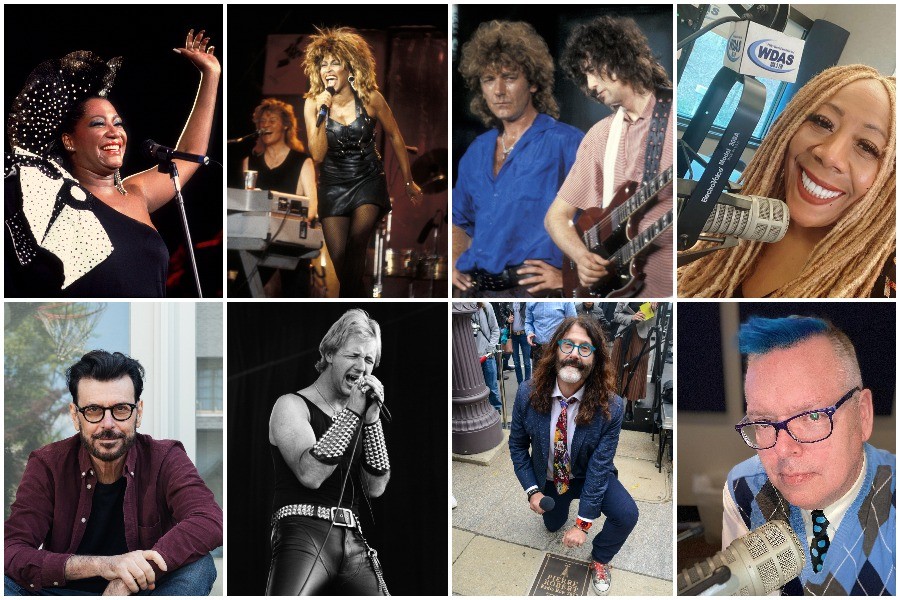
Clockwise from top left: Patti LaBelle at Live Aid (Getty Images); Tina Turner at Live Aid (Getty Images); Robert Plant and Jimmy Page during the Led Zeppelin reunion at Live Aid (Getty Images); WDAS personality Patty Jackson (file photo); WXPN personality Robert Drake (file photo); WMMR personality Pierre Robert (Getty Images); Rob Halford of Judas Priest (Getty Images); Eric Bazilian of the Hooters (file photo).
Getting There
Rob Halford, lead singer, Judas Priest: We were in the Bahamas working on the Turbo album. We knew the concert was happening — it was all over the news, 24/7. But we really didn’t know until a few days before that there was an opening for us. We flew up the day before, and I don’t think we even rehearsed for it.
Jerry Blavat, the late local DJ: I arranged for a limo for Madonna from the airport — a super-stretch limo. And she had to have dinner. So we went down to Frankie’s Seafood Italiano at 11th and Tasker. It was early, so they weren’t open yet. I ordered ahead. She wanted chicken parmigiana. And I said, “The veal here is excellent.” But she said nah, nah. She also wanted broccoli and spinach. She ate in the limo, and then we went to the stadium.
George Thorogood, blues singer/guitarist, Wilmington native: At that point, it was still very early on for us. We got our start in ’77, and we were still trying to make a living. There was a last-minute cancellation at Live Aid, and they suggested we fill in for the band that couldn’t make it. I was on the West Coast and had to fly all the way to Philly. It was a red-eye, and I got no sleep. Got in at some ungodly hour.
Pierre Robert, WMMR DJ: [Rolling Stones guitarist] Ronnie Wood recently told me that he drove down from New York with Bob Dylan for Live Aid. In Bob Dylan’s pickup truck. How fucking cool is that?
Eric Bazilian, Hooters front man: We spent the entire day before — the Friday — waiting for the sound check that never came. But we did get to see Mick Jagger and Tina Turner rehearsing.
Tina Turner, the late singer, in an MTV backstage interview the day of the show: We had about an hour. [Laughs]. But, c’mon, it’s not about perfection… It’s just about having a good time and being here for the people. We might mess up a few lines. But we’re here.
Eric Bazilian: It was a lot of sit-around-and-wait, but it was fun. The place was buzzing, and it was obvious that something historic was happening. And then on Saturday, we got picked up from our homes around 6:30 in the morning. I was living in Old City at 3rd and Vine back then.
Brian Wilson, Beach Boys co-founder: They called me and asked me if I wanted to do it. We hadn’t played together for a long time. We had a lot of bad feelings.
Tom Bailey, Thompson Twins co-founder: We were pretty close to our peak of activity, particularly in the States. But we missed the boat on the charity single “Do They Know It’s Christmas?” because someone left a message for us but it didn’t get passed on. We told them to keep us in mind for anything else, so we got the call. We were in New York and all drove down together. It was strange to me that we weren’t flying, but I guess it was actually quicker than going to the airport.
Kenny Loggins, singer/songwriter, ’80s soundtrack hit-maker: It was very last-minute. My memory of it is that it was sort of like, “How quick can you get to Philadelphia?”
Patti LaBelle, soul legend, Wynnewood resident: I don’t even remember who asked me to do it. But I do know that I said a quick yes. I was very excited. But then what I wasn’t excited about was the helicopter we flew in on. I had a speaking engagement — I think in New York — and I had to fly in on that thing. It was terrifying.
Tony Thompson, the late session musician who wound up performing as part of the Led Zeppelin reunion, in a 2002 interview: I was on the road… in Sarasota, Florida. I got a call from my road manager saying Jimmy Page and Robert Plant were on the phone. I was like, “Yeah, right.” [Laughs]. And I hung up the phone. About a half hour later, my road manager calls back again and says, “Tony, don’t hang up the phone. I have Robert and Jimmy on a three-way call from Chicago, and they want to talk to you.” I was like, “Are you serious?” So I talk to them, and it turned out they were fans of my work, so they asked me if I would consider doing Live Aid with them.
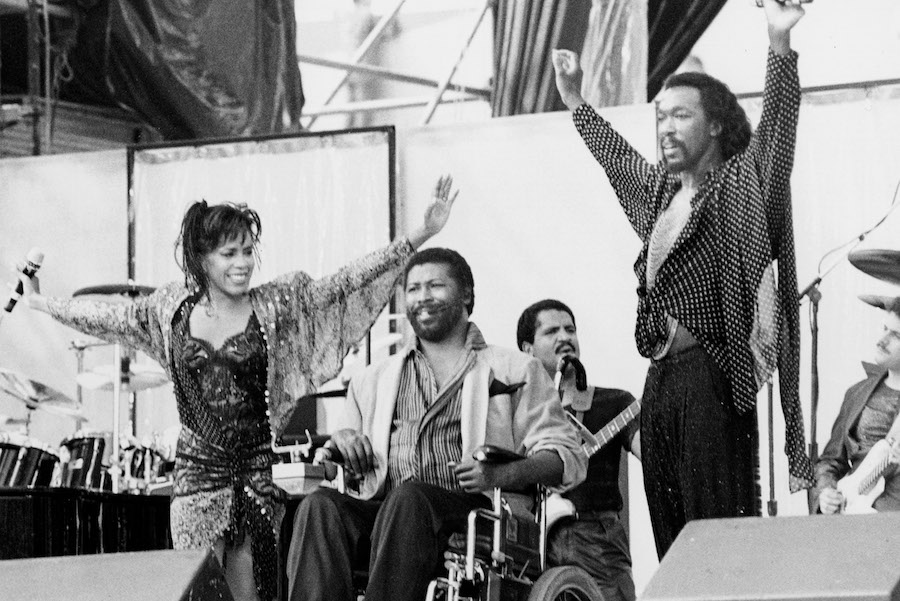
Teddy Pendergrass (center) with Ashford & Simpson at JFK Stadium for Live Aid (Getty Images)
Teddy Pendergrass, the late Philly singer who performed in a wheelchair with Ashford & Simpson, three years after a car crash left him paralyzed from the chest down, in an undated interview prior to his 2010 death: I was asked to do Live Aid by my manager. This was the same person who said to me, about a year or two after I was injured, he said, “Ted, it’s not how you fall down. It’s how you get up.” So he told me that there’s going to be a big concert and that he could get me in. I said OK. I needed to know how people would react to me.
Valerie Simpson of Ashford & Simpson: We got involved through Teddy. He hadn’t performed since his accident, and he had a little trepidation. He asked us to perform with him so he would be comfortable. And at that time, we were probably getting more recognition than we ever had. So it was a good time for us to be on a larger scale. Actually, that was the largest scale any of the performers had probably every been on.
Robert Drake, now a WXPN personality: I was able to get a free ticket, and this concert had a lot of buzz around it, in part because MTV was all over it and everybody watched MTV back then.
Tigre Hill, filmmaker: My mother’s friend was a doctor and she scored some tickets. I was friends with her son, John-John. She called my mom and said, “Do you think our kids would wanna go to Live Aid?” Hell yeah!
Patty Jackson, now a WDAS personality: I had just entered radio after graduating from South Philly High Motivation. I was working for WSSJ in Camden, and we would play a little bit of everything, including a lot of the artists and the music that was at Live Aid. So it was exciting beyond belief to have this happening in the city and have all those superstars coming. But I didn’t go to the concert. I watched it from home in South Philly. I was glued to the tube.
Bette Askins, Fitler Square resident, retired court employee: My daughter Meegan, who was a teenager at the time, told me she got tickets for her and her girlfriend, and I said, “Well, you gotta get me a ticket!”
Pierre Robert: Bill Graham took one look at JFK Stadium and said, “What a fucking dump.” So they asked for help cleaning it up, and I volunteered for a few days before the concert. And by doing that, I got an all-access pass to the show. WMMR didn’t have the rights to the broadcast, so we were broadcasting outside in a Winnebago. It was the wildest fucking thing.
David Weinstein, then an unknown 18-year-old singer from Miami Beach, Florida, who opened Live Aid: I had this idea that I wanted to get a tape of my song into Bill Graham’s hands, so I got my mother’s Texaco card and drove up maybe 10 days before. I camped out in the parking lot at JFK Stadium and eventually met Bill. I said that I wanted to play at Live Aid. A few days later, he comes out — I’m still camped out in the parking lot — and he says, “Let’s give it a go.” So I called my folks, and they got on the airplane.
Showtime
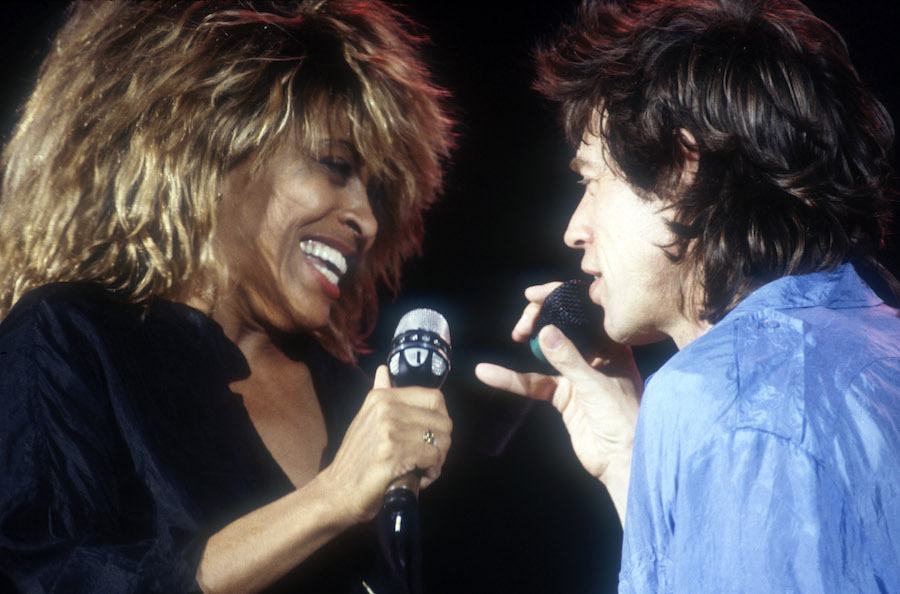
Tina Turner and Mick Jagger at Live Aid in Philadelphia (Getty Images)
David Weinstein: I was the first, so everything was in my favor to blow them away. But my performance was sort of a disaster. A string popped, and my voice broke. I was so nervous. I don’t even remember the song.
Pierre Robert: After that guy, Joan Baez came on and announced, “Children of the ’80s: This is your Woodstock.” And then the Hooters.
Eric Bazilian: Jack Nicholson was there and gave us a thumbs-up and said, “Go get ’em.” We played “All You Zombies” and “And We Danced.” And we nailed it. We really did.
Robert Drake: I got there when the Hooters were on, and our seats may have been free, but they were in the middle of nowhere. Thankfully, I was close enough to get sprayed when they turned on those water cannons. It was beastly hot, and of course JFK had no shade whatsoever. We’d watch whatever was happening on the giant video screen, and when the Philly act finished, they’d switch over to the simulcast in Wembley, and we’d watch that while they were setting up the next band here.
Bette Askins: Since we had general admission tickets, we had arrived there at nine o’clock. Well, that wasn’t early enough. There were people everywhere. We just kept pushing forward toward the stage. But everywhere we tried to get to, there were too many people. So I said to Meegan, “Fuck this, let’s go up to the stands.”
Tigre Hill: They dropped off me and John-John at 2 o’clock, which was late. I remember walking into the stadium and immediately smelling the marijuana. We got a major contact high, and I had never been high before.
Kenny Loggins: Things were moving so fast — run them on and run them off. Bill Graham was in charge of everything, and you couldn’t fuck around.
Robert Drake: I remember that we stumbled upon a case of water, which was pretty weird. Keep in mind that bottled water wasn’t really a thing back then. There was a definite issue of making sure that people didn’t pass out.
Brian Wilson: The audience was full of energy and love. We got a lot of love, and it was a great night for all of us. It was a pleasure being there.
Stephen Starr, former concert promoter, now a restaurant mogul: Madonna’s set was like a Las Vegas revue. She was ridiculous back then. I booked her first big tour — the “Like a Virgin” tour — at the Spectrum. And what she did at Live Aid was pretty much that show.
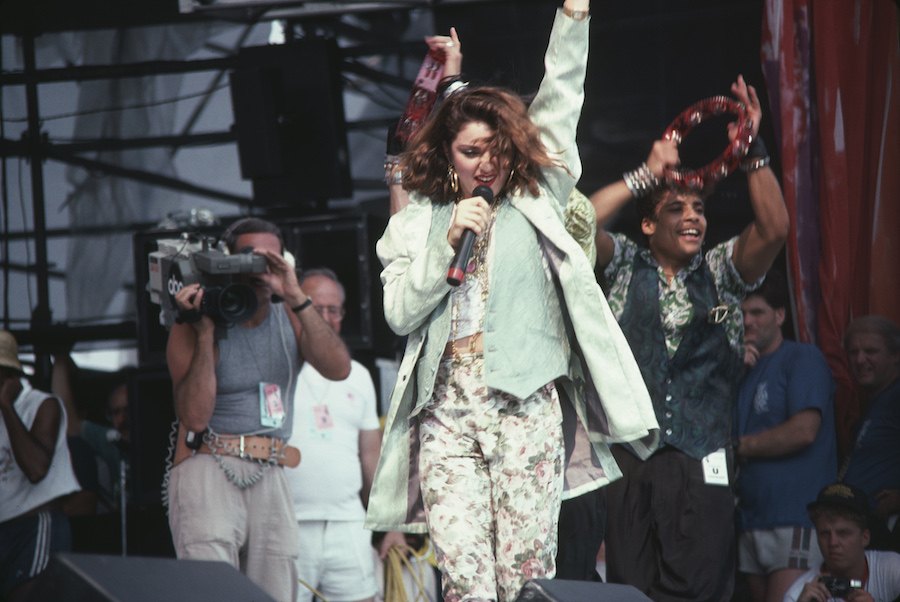
Madonna performing at JFK Stadium for Live Aid (Getty Images)
Patty Jackson: I was Madonna-crazy back then, so Madonna really made an impression on me.
David Weinstein: Madonna was kick-ass. Neil Young singing “Sugar Mountain.” And Crosby, Stills & Nash was the best performance of the day. The heavy metal acts didn’t move me much. I regard that as adolescent tripe.
Robert Drake: The Black Sabbath set was so cool, although it was odd to have Chevy Chase introduce them. It’s like having your dad introduce Black Sabbath. And the Thompson Twins were a highlight. I left around the Led Zeppelin thing. It was a long day, and it was getting a little crazy. But then when I got off the subway, I heard that Duran Duran had just finished. I regretted missing that.
David Weinstein: You have to remember that JFK was on its last legs. The bathrooms were horrendous.
George Thorogood: It was very hot and I was very sleepy, but that’s what we do. Professionals make it look smooth. When Gene Kelly was in Singin’ in the Rain, he had a temperature of 105. … It was a really great reception, because they weren’t expecting to see us and this was our home turf.
Tom Bailey: Things were running late, so we had to cut one of our three songs. We did “Hold Me Now” and the Beatles song “Revolution” with Madonna. We had some sort of backstage deal where we agreed to sing backing vocals on each other’s set. Keep in mind that Madonna wasn’t quite the elder stateswoman of American pop music that she is today.
Kenny Loggins: I’m a scrambling kind of get-it-in-and-get-it-done rock guy, and I could have played “Footloose” in my sleep.
Valerie Simpson: I don’t really remember much directly from that day. You’re on an emotional high. You have this adrenaline. You want to get it right and lift up the crowd. When I look back and see the footage, it looks right. All the way right. I very much still love the moment, love how we looked surrounding Teddy. And the performance we put in was heartfelt. The message of that song we did — “Reach Out and Touch Somebody’s Hand” — was what that day was all about.
Rob Halford: I’ve seen the YouTube, and I’m proud of it. You barely had 15 minutes, and every band was pushing the pedal to the metal. It was boiling hot that day, and we were in leather. But it is what it is, as Slash said to me a few weeks ago in Australia, where the onstage temperature was 120 degrees. It is what it is.

Rob Halford and other members of Judas Priest performing at JFK Stadium for Live Aid (Getty Images)
Bette Askins: It was so fucking hot. The heat was so intense. I heard that they had opened up a pipe in the men’s room to be like a shower, so I went in to cool down and it wound up being like a wet t-shirt contest. I was in my 30s then. It was so crazy, so incredible. Meegan and her girlfriend were having fun and dancing, so I got up and danced in my wet t-shirt.
Patty Jackson: Yeah, that was a hot day. But you know what was just as steamy as the day itself? That Tina Turner and Mick Jagger performance. Hot.
Mark Goodman, MTV VJ, host of the all-day television broadcast: We had amazing seats, right on the stage. We were looking out at all of those people just like the bands were. For me, the big one to see was the quote-unquote Led Zeppelin reunion. In the moment it seemed fine, but afterward we heard what a mess it was, and Phil Collins [who played drums for the set] wouldn’t allow it to be aired again.
Robert Plant, Led Zeppelin singer, in a 1988 Rolling Stone interview: It was horrendous.
Jimmy Page, Led Zeppelin guitarist, in a subsequent interview: My main memories … were of total panic.
Phil Collins in a Q magazine interview, 2014: It was a disaster, really.
Pierre Robert: I went out into the audience for the Led Zeppelin reunion. It was magical. Phil Collins played at the Wembley concert in the morning and then flew over in the Concorde to play drums for Led Zeppelin in Philadelphia. No one got an encore. So you have the Led Zeppelin reunion, they do three songs and that’s it. The crowd went out of their minds. I was worried they were going to tear the place apart. But then four guys walk out and sit in chairs onstage, and that was the Crosby, Stills, Nash and Young reunion — the only thing that could have calmed down the crowd at that point.
Stephen Starr: That Phil Collins thing really stands out to me. And Tina Turner and Mick Jagger were just awesome. But Bob Dylan with Keith Richards — that was weird. There was something off.
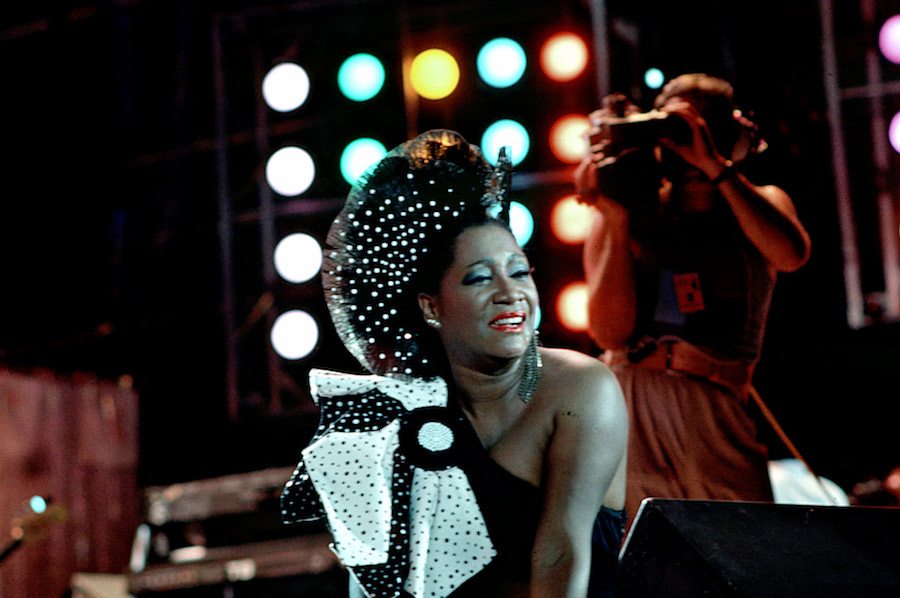
Patti LaBelle performing at Live Aid at JFK Stadium in Philadelphia (Getty Images)
Patti LaBelle: It was my son’s first time seeing his mother perform. I had that crazy hair, and he was standing there very proud. I remember I ended up walking into the audience with no shoes on, and there was water, and everyone was worried that I was going to get electrocuted.
Patty Jackson: Patti was dressing flamboyantly in those days. And her hair was big. She performed wonderfully.
Tigre Hill: I really don’t remember much about the performances. I would have to go back and watch the DVD. What I do remember was that we started off at the back of the stadium and then at maybe 4:30 or so, we started a march from the back and we kept going. We were pretty high, which emboldened our approach. We kept moving and moving and by 7 or so, we were in the very front row. I do remember Duran Duran. I wasn’t a Duran Duran fan until I saw them at Live Aid. And Patti LaBelle. And “We Are the World.”
Eric Bazilian: The finale of “We Are the World” was so cool. I had Bob Dylan and Ron Wood behind me to my right and Eric Clapton behind me on the other side. I remember hearing this guitar and saying, “Wow, that really sounds like Eric Clapton.” And I turn around, and there is Eric Clapton. Everybody was jockeying for position, but I wasn’t into that. If the camera wants to find me, it will find me.
Kenny Loggins: I was in on the closing song, but shit, I don’t even remember what it was. Maybe a Beatles tune? All I remember was — what’s her name? This Black woman with the voice of God. It was her turn to sing, and she was screaming on the microphone. It was so loud. So overwhelmingly loud. There were at least 12 mics onstage, and the sound guy had to be trying to figure out what mic she was on to turn it down. It was hilarious.
Patti LaBelle: What can I say — I got the spirit.
Backstage
Jerry Blavat: If you went into Frank Sinatra’s dressing room, there would be a bowl of chewing gum, and Sammy Davis, he always had a bowl of candies. This was quite different. This was rock-and-roll. Everybody accommodated whatever they wanted. There was a lot of pot going on. And they were doing their — it’s not for me — the coke was their thing, the blow. You know, cocaine.
George Thorogood: I’m not a big backstage guy. Once I get there, I play. And then I want to get the hell out of there.
Kenny Loggins: Everyone was moving around backstage with their entourages and security people. They were all protecting each other from each other, all these hierarchical movements.
Stephen Starr: They built this fantastic Hard Rock Cafe restaurant tent back there. They replicated Hard Rock when it was still cool. And I was back there by virtue of my connections. Mick Jagger and Tina Turner were there. And, for some reason, George Segal. I have no idea why. And Jack Nicholson kept popping up everywhere.
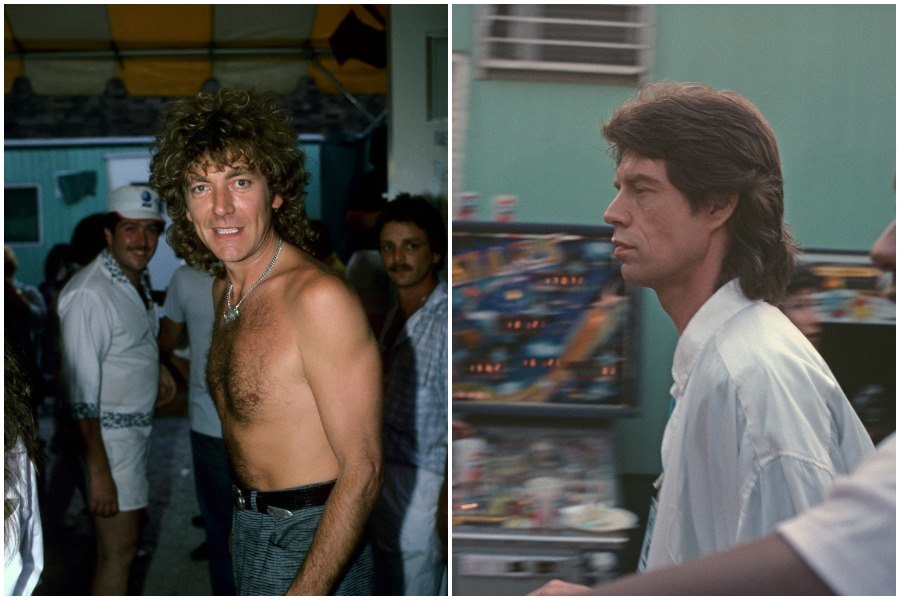
Robert Plant and Mick Jagger backstage at JFK Stadium during Live Aid (Getty Images)
Pierre Robert: Because I had that all-access pass, I would run these kamikaze missions backstage to get interviews. I saw Jack Nicholson back there and asked him for one, and he said, “Sure, kid, why not?” I also got Neil Young, the Beach Boys, Graham Nash. And then I’d run back to the Winnebago and we’d cut and broadcast.
Tigre Hill: At some point during the show, I managed to get past a guard and wound up side-stage and then backstage. John-John and I got separated, and it a miracle we ever reconnected. Keep in mind this was before cell phones. I’m not sure how long I was back there, but I was literally feet away from Mick and Tina and Ronnie Wood and Patti LaBelle, and I kept running into Jeff Bridges, for whatever reason. Oh, and Lionel Richie! He was big back then. And this was before social media, so when you saw stars, it was kind of exciting. But then a security guard made me leave the area.
Robert Halford: My big moment was meeting up with Jack Nicholson, who is a metalhead. We talked backstage. And I also met Joan Baez. We had done a cover of her song “Diamonds and Rust,” and she walks up to me and says, “I just want to give you a message.” And I think, Oh, Lord. But then she says, “My son has told me to tell you that he prefers your version to his mum’s.” How self-effacing? An incredible, iconic, legendary woman. There was my Joan Baez moment.
Mark Goodman: Jack Nicholson was the big hubbub when he arrived. He was holding court. People were pretty comfortable being there. But nobody could get to Madonna.
Tom Bailey: I was quite starstruck when I was back there talking to Madonna and wound up in a room set aside for official photographers, and there were Mick, Bob and Tina sitting in that same room.
Eric Bazilian: It was all about business early on. Later in the day, it loosened. I was hanging out with Duran Duran. All in a day’s work. But then I went home and watched most of the rest on TV. It was just unbearably hot and crowded. I figured I’d enjoy it more sitting in my air-conditioned living room. But I went back for the finale.
Stephen Starr: Everybody who was anybody was back there.
Rob Halford: But the real party was after the event in a private penthouse suite in downtown Philly. I was standing with Jack, and people were going on about The Shining. And I said, “You get that all the time, Jack?” And he said, “Yeah,” and then starts singing [Judas Priest’s] “Breaking the Law.” That party was pretty wild. There was a sauna in the penthouse that was being very well used. I wandered in, and there was a bit of Caligula going on. But I can’t tell you quite who was involved. It was too dark and steamy.
Live Aid’s Legacy
Kenny Loggins: Very few acts actually watched where the money went. Half of what you do is for promotion, to get on-camera, to get in on the big things, and the other half is that you’re hoping that you’re aligned with the right people, who will hopefully do the right thing.
Rob Halford: Live Aid showed how music can bring the world together.
Jerry Blavat: It was the event. You’ll never be able to get all of that talent together to agree to do something like that again. It’s completely different today. Artists like Beyoncé or Kanye West — they dictate to the record companies.
Patti LaBelle: It should happen again. Why not? Bring it back for peace. Peace all over the world.
Mark Goodman: Nothing since has compared to the enormity of Live Aid. It was immense. A phenomenon. Everybody was taken up with the spirit of giving.
Pierre Robert: This was as magical as you can get, and the eyes of the world were on Philadelphia. The vibe in Philly that day was just incredible. But one day later, that energy had flown away.
Robert Drake: The spotlight was on us, and this time, it was for something positive. This was so important coming right after MOVE. There was a lot of conversation about how we needed to shake up all that negative press. I had a lot of Philly pride once it was all said and done.
Tom Bailey: It was the untouchable concert of all time, the greatest possible experience. Now it’s all about celebrity instead of the music. The headlines overtake the content. It’s an ego-boosting circus.
Stephen Starr: There was this feeling. You knew that you were part of a history-making thing. Everybody was happy — like one big backyard picnic. But really, it was the last cool thing in Philly.
Portions of this story originally appeared in print as “Sex, Drugs and Live Aid” in the July 2015 edition of Philly Mag.


